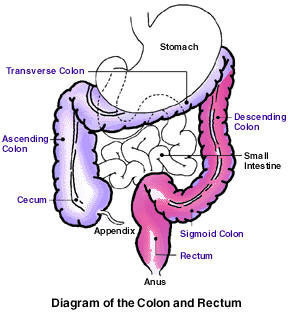

About Colonoscopy:
LSACCA
Lori Shelton Alliance for
Colon Cancer Awareness
Colonoscopy is a short, outpatient test (usually about 30 minutes), and is the most effective method for prevention and early detection of colon cancer.
- A flexible scope inspects the entire colon (a sigmoidoscopy examines 1/3 of the colon as indicated in the diagram below).
- It allows for the discovery and immediate removal of pre-cancerous polyps, which themselves are rarely symptomatic.
- Everyone should have a colonoscopy by the age of 50 (or earlier for people with a family history of the disease).
Please discuss this lifesaving test with your doctor.
While other screening methods are used, we strongly believe colonoscopy should be the primarily recommended screening tool for the following reasons:
- In the largest study ever done on screening the entire colon for cancer in people without symptoms, 10% of the people aged 50-75 were found to have colon cancer or serious precancerous growths (1/3+ would have been missed by sigmoidoscopy.)1
- The often-recommended screening method using both a fecal occult-blood test with a sigmoidoscopy fails to detect advanced polyp or tumor growth in at least 24% of people.2
- According to Dr. David Walden, gastroenterologist at St. Luke's Hospital in St. Louis, approximately half of all sigmoidoscopies result in the need for a colonoscopy follow-up.
- Unlike prior surveys which indicated a majority of polyps and tumors were located in the portion of the colon reachable by a sigmoidoscopy, more recent studies show that abnormal growths are more uniformly distributed throughout the colon.1
- According to the American Cancer Society, positive results from any other screening test should be followed by a colonoscopy for more complete diagnostic evaluation.3
- Colonoscopies not only have the advantages of viewing the entire colon and removing polyps, but they can also diagnose other diseases.3
The area shaded in red is the extent of the colon examined in a sigmoidoscopy. A colonoscopy examines the entire colon through the cecum.

(Source: www.cdc.gov/cancer/ScreenforLife/info.htm)
Fewer than 35% of people over age 50 have ever had a colonoscopy and fewer than 75% of those had one in the past 5 years.4 Because of the low level of screening, only 37% of colon cancer cases are diagnosed when the disease is still localized.3
LSACCA recognizes that some people will choose not to undergo the colonoscopy. As Dr. Sidney Winawer, a gastroenterologist at Memorial Sloan-Kettering hospital says, "The best test is the test that gets done." The other screening options (fecal occult blood test, flexible sigmoidoscopy, and/or double contrast barium enema) are better than nothing.
Virtual Colonoscopy
Virtual colonoscopies are getting a lot of attention recently as a more comfortable, less expensive, nearly as accurate alternative to conventional colonoscopy. There are also disadvantages with the virtual, which include: one still must go through the bowel prep, the doctor still pumps air into the intestines, and insurance companies are mostly not covering it yet. If polyps are found, then a conventional colonoscopy will be required to remove the polyps. When there is reluctance to get the conventional test, the virtual is a good alternative. Excellent information regarding virtual colonoscopies can be found at www.virtualcolonoscopy.net.
Preparation
Many people are resistant to get a colonoscopy for fear of the preparation. The prep is necessary to completely empty the colon to allow for a thorough and safe exam. As Priscilla Savary of the Colon Cancer Network notes, "A c-scope and a snip is a far cry from surgery, chemo, and radiation" or worse.
To prepare for the procedure, you may have to follow a liquid diet for at least one day beforehand. In addition, since you will be given sedative and pain medication, which puts you in "twilight" for the exam, you will need to have someone take you home afterward.
New preps are available. Ask your doctor about the VisicolTM tablets, which are taken in two doses of 30 grams approximately twelve hours apart, which rapidly and effectively cleanses the entire colon.
Phospho-soda is another common prep, in which 3 ounces of phospho-soda are taken as recommended the prior day.
Preparation with GolytelyTM, ColyteTM, or NulytelyTM, in which a gallon of the product is consumed the prior day, is another common choice.
Your physician will provide you with more detailed instructions. LSACCA intends only to provide general information, and does not act as a definitive basis for diagnosis or treatment in any particular case.
Join the campaign to eradicate colorectal cancer by committing to be screened at www.finditfirst.com.
1 Use of Colonoscopy to Screen Asymptomatic Adults for Colorectal Cancer, New England Journal of Medicine, 343(3), pp. 162-168.
2 One-Time Screening for Colorectal Cancer with Combined Fecal Occult-Blood Testing and Examination of the Distal Colon, New England Journal of Medicine, 345(8), pp. 555-560.
3 Cancer Facts and Figures 2002, American Cancer Society.
4 Nationwide 1999 Colorectal Cancer Screening Data, Behavioral Risk Factor Surveillance System.